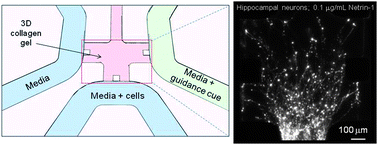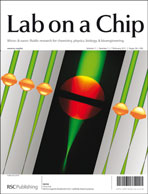A high-throughput microfluidic assay to study neurite response to growth factor gradients†
Abstract
Studying neurite guidance by diffusible or substrate bound gradients is challenging with current techniques. In this study, we present the design, fabrication and utility of a microfluidic device to study neurite guidance under chemogradients. Experimental and computational studies demonstrated the establishment of a steep gradient of guidance cue within 30 min and stable for up to 48 h. The gradient was found to be insensitive to external perturbations such as media change and movement of device. The effects of netrin-1 (0.1–10 µg mL−1) and brain pulp (0.1 µL mL−1) were evaluated for their chemoattractive potential on neurite turning, while slit-2 (62.5 or 250 ng mL−1) was studied for its chemorepellant properties. Hippocampal or dorsal root ganglion (DRG) neurons were seeded into a micro-channel and packed onto the surface of a 3D collagen gel. Neurites grew into the matrix in three dimensions, and a gradient of guidance cue was created orthogonal to the direction of neurite growth to impact guidance. The average turning angle of each neurite was measured and averaged across multiple devices cultured under similar conditions to quantify the effect of guidance cue gradient. Significant positive turning towards gradient was measured in the presence of brain pulp and netrin-1 (1 µg mL−1), relative to control cultures which received no external guidance cue (p < 0.001). Netrin-1 released from transfected fibroblasts had the most positive turning effect of all the chemoattractive cues tested (p < 0.001). Slit-2 exhibited strong chemorepellant characteristics on both hippocampal and DRG neurite guidance at 250 ng mL−1 concentration. Slit-2 also showed similar behavior on DRG neuron invasion into 3D collagen gel (p < 0.01 relative to control cultures). Taken together, the results suggest the utility of this microfluidic device to generate stable chemogradients for studying neurobiology, cell migration and proliferation,


 Please wait while we load your content...
Please wait while we load your content...